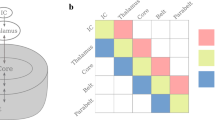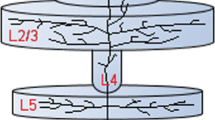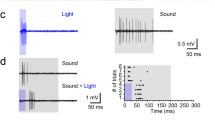Abstract
Travelling waves of activity in neural circuits have been proposed as a mechanism underlying a variety of neurological disorders, including epileptic seizures, migraine auras and brain injury. The highly influential Wilson-Cowan cortical model describes the dynamics of a network of excitatory and inhibitory neurons. The Wilson-Cowan equations predict travelling waves of activity in rate-based models that have sufficiently reduced levels of lateral inhibition. Travelling waves of excitation may play a role in functional changes in the auditory cortex after hearing loss. We propose that down-regulation of lateral inhibition may be induced in deafferented cortex via homeostatic plasticity mechanisms. We use the Wilson-Cowan equations to construct a spiking model of the primary auditory cortex that includes a novel, mathematically formalized description of homeostatic plasticity. In our model, the homeostatic mechanisms respond to hearing loss by reducing inhibition and increasing excitation, producing conditions under which travelling waves of excitation can emerge. However, our model predicts that the presence of spontaneous activity prevents the development of long-range travelling waves of excitation. Rather, our simulations show short-duration excitatory waves that cancel each other out. We also describe changes in spontaneous firing, synchrony and tuning after simulated hearing loss. With the exception of shifts in characteristic frequency, changes after hearing loss were qualitatively the same as empirical findings. Finally, we discuss possible applications to tinnitus, the perception of sound without an external stimulus.










Similar content being viewed by others
Notes
The peak values and variances of the Gaussian functions defined in this subsection are chosen so that a tonal stimulus would only excite a small portion of the pyramidal neurons. See the model response to a 723-Hz pure tone in Fig. 8 for an example.
References
Basta, D., & Ernest, A. (2004). Noise-induced changes of neuronal spontaneous activity in mice inferior colliculus brain slices. Neuroscience Letters, 368, 297–302.
Bhattacharyya, T., & Dayal, V. (1989). Influence of age on hair cell loss in the rabbit cochlea. Hearing Research, 40, 179–183.
Brozoski, T., Bauer, C., & Caspary, D. (2002). Elevated fusiform cell activity in the dorsal cochlear nucleus of chinchillas with psychophysical evidence of tinnitus. Journal of Neuroscience, 22, 2383–2390.
Bruce, I., Bajaj, H., & Ko, J. (2003). Lateral-inhibitory-network models of tinnuts. In Proceedings of the 5th IFAC symposium on modeling and control in biomedical systems (pp. 359–363). Dordrecht: Elsevier.
Burrone, J., & Murthy, V. (2003). Synaptic gain control and homeostasis. Current Opinion in Neurobiology, 13, 560–567.
Calford, M. (2002). Dynamic representational plasticity in sensory cortex. Neuroscience, 111, 709-738.
Calford, M., Rajan, R., & Irvine, D. R. F. (1993). Rapid changes in the frequency tuning of neurons in cat aduitory cortex resulting from pure-tone-induced temporary threshold shift. Neuroscience, 55(4), 953-964.
Charles, A. & Brennan, K. (2009). Cortical spreading depression-new insights and persistent questions. Cephalagia, 29(10), 1115–1124.
Chen, Q., & Jen, P. (2000). Bicuculline application affects discharge patterns, rate-intensity functions, and frequency tuning characteristics of bat auditory cortical neurons. Hearing Research, 150, 161–174.
Cheung, S., Bedenbaugh, P., Nagarajan, S., & Schreiner, C. (2001). Functional organization of squirrel monkey primary auditory cortex: Responses to pure tones. Journal of Neurophysiology, 85, 1732–1749.
Dayan, P., & Abbott, L. F. (2005). Theoretical neuroscience: Computational and mathematical modeling of neural systems. The MIT Press.
Desai, N., Cudmore, R., Nelson, S., & Turrigiano, G. (2002). Critical periods for experience-dependent synaptic scaling in visual cortex. Nature Neuroscience, 5, 783–789.
Dietrich, V., Nieschalk, M., Stoll, W., Rajan, R., & Pantev, C. (2001). Cortical reorganization in patients with high frequency cochlear hearing loss. Hearing Research, 158, 95–101.
Dominguez, M., Becker, S., Bruce, I., & Read, H. (2006). A spiking neuron model of cortical correlates of sensorineural hearing loss: Spontaneous firing, synchrony and tinnitus. Neural computation, 18(12), 2942–2958.
Douglas, R., & Martin, K. (1998). Neocortex. In G. M. Shepherd (Ed.), The synaptic organization of the brain (pp. 459–509). New York: Oxford University Press.
Eggermont, J. (2000). Sound induced correlation of neural activity between and within three auditory cortical areas. Journal of Neurophysiology, 83, 2708–2722.
Eggermont, J. (2003). Central Tinnitus. Auris Nass Larynx, 30, 7–12.
Eggermont, J. (2005). Tinnitus: Neurobiological substrates. Drug Discovery Today 19, 1283–1290.
Eggermont, J., & Roberts L. E. (2004). The neuroscience of Tinnitus. Trends in Neurosciences, 27, 676–682.
Foeller, E., Vater, M., & Kossl, M. (2001). Laminar analysis of inhibition in the gerbil primary auditory cortex. Journal of the Association for Research in Otolaryngology, 2(3), 279–296.
Fröhlich, F., Bazhenow, M., & Sejnowski, T. (2008). Pathological effect of homeostatic synaptic scaling on network dynamics in diseases of the cortex. Journal of Neuroscience, 28(7), 1709–1720.
Gerken, G. (1996). Central tinnitus and lateral inhibition: An auditory brainstem model. Hearing Research, 97, 75–83.
Gestner, W., & Kistler, W. (2002). Spiking neuron models: Single neurons, populations, plasticity. Cambridge University Press.
Greenwood, D. (1990). A cochlear frequency-position function for several species-29 years later. Journal of the Acoustical Society of America, 87, 2592–2605.
Houweling, A., Bazhenov, M., Timofeev, I., Steriade, M., & Sejnowski, T. (2005). Homeostatic synaptic plasticity can explain post-traumatic epileptogenesis in chronically isolated neocortex. Cerebral Cortex, 15, 834–845.
Hwa, T., & Kardar, M. (1992). Avalanches, hydrodynamics, and discharge events in models of sandpiles. Physical Review A, 45, 7002–7023.
Jones, E. (1995). Overview: Basic elements of the cortical network. In M. J. Gutnick & I. Moody (Ed.), The Cortical Neuron (pp. 111–122). New York: Oxford University Press.
Kaltenbach, J. (2000). Neurophysiologic mechanisms of Tinnitus. Journal of the American Academy of Audiology, 11, 125–137.
Kaltenbach, J., Zacharek, M., Zhang, J., & Frederick, S. (2004). Activity in the dorsal cochlear nucleus of hamsters previously tested for tinnitus following intense tone exposure. Neuroscience Letters, 355, 121–125.
Kilman, V., van Rossum, M., & Turrigiano, G. (2002). Activity deprivation reduces miniature IPSC amplitude by decreasing the number of postsynaptic GABA(A) receptors clustered at neocortical synapses. Journal of Neuroscience, 22, 1328–1337.
Komiya, H., & Eggermont, J. (2000). Spontaneous firing activity of cortical neurons in adult cats with reorganized tonotopic map following pure-tone trauma. Acta Otorhinolaryngologica, 120, 750–756.
Konig, O., Schaette, R., Kempter, R., & Gross, M. (2006). Course of hearing loss and occurrence of tinnitus. Hearing Research, 221, 59–64.
Kotak, V., Fujisawa, S., Lee, F., Aoki, C., & Sanes D. (2005). Hearing loss raises excitability in the auditory cortex. Journal of Neuroscience, 25, 3908–3918.
Liberman, M. (1987). Chronic ultrastructural changes in acoustic trauma: Serial-section reconstruction of stereocilia and cuticular plates. Hearing Research, 26, 65–88.
Leslie, K., Nelson, S., & Turrigiano, G. (2001). Postsynaptic depolarization scales quantal amplitude in cortical pyramidal neurons. Journal of Neuroscience, 21, 1–6.
Lu, Y., & Jen, P. (2001). GABAergic and glycinergic neural inhibition in excitatory frequency tuning of bat inferior collicular neurons. Experimental Brain Research, 141, 331–339.
Markram, H., Lubke, J., Frotscher, M., & Sakmann, B. (1997). Regulation of synaptic efficacy by coincidence of postsynaptic APs and EPSPs. Science, 275, 213–215.
Merzenich, M., Knight, P., & Roth, G. (1975). Representation of cochlea within primary auditory cortex in the cat. Journal of Neuroscience, 38, 231–249.
Miller, L., Escabi, M., Read, H., & Schreiner, C. (2001). Functional convergence of response properties in the auditory thalamocortical system. Neuron, 32, 151–160.
Milner, P. M. (1958). Note on a possible correspondence between the scotomas of migraine and spreading depression of Leao. Electroencephalography and Clinical Neurophysiology, 10, 705.
Muhlnickel, W., Elbert, T., Taub, E., & Flor, H. (1998). Reorganization of auditory cortex in tinnitus. Proceedings of the National Academy of Sciences, 95, 10340–10343.
Muly, S., Gross, J., & Potashner, S. (2004). Noise trauma alters D-[3H]aspartate release and AMPA binding in chinchilla cochlear nucleus. Journal of Neuroscience Research, 75, 585–596.
Noreña, A. & Eggermont, J. (2003). Changes in spontaneous neural activity immediately after an acoustic trauma: Implications for neural correlates of tinnitus. Hearing Research, 183, 137–153.
Noreña, A., Tomita M., & Eggermont, J. (2003). Neural changes in cat auditory cortex after a transient pure-tone trauma. Journal of Neurophysiology, 90, 2387–2401.
Ottaviani, F., Di Girolamo, S., Briglia, G., De Rossi, G., Di Giuda, D., & Di Nardo, W. (1997). Tonotopic organization of human auditory cortex analyzed by SPET. Audiology, 36, 241–248.
Parra, L. C. & Pearlmutter, B. A. (2007). Illusory percepts from auditory adaptation. Journal of the Acoustical Society of America, 121, 1632–1641.
Phillips, D., & Irvine, D. (1981). Responses of single neurons in physiologically defined primary auditory cortex AI of the cat: Frequency tuning and responses to intensity. Journal of Neurophysiology, 45, 48–58.
Popelar, J., Erre, J., Aran, J., & Cazals, Y. (1994). Plastic changes in ipsicontralateral differences of auditory cortex and inferior colliculus evoked potentials after injury to one ear in the adult guinea pig. Hearing Research, 72, 125–134.
Rajan, R. (1998). Receptor organ damage causes loss of cortical surround inhibition without topographic map plasticity. Nature Neuroscience, 1, 138–143.
Rajan, R. (2001). Plasticity of excitation and inhibition in the receptive field of primary auditory cortical neurons after limited receptor organ damage. Cerebral Cortex, 11, 171–182.
Rajan, R., Irvine, R., Wise, L., & Heil, P. (1993). Effect of unilateral partial cochlear lesions in adult cats on the representation of lesioned and unlesioned cochleas in primary auditory cortex. Journal of Comparative Neurology, 338, 17–49.
Read, H., Winer, J., & Schreiner, C. (2002). Functional architecture of the auditory cortex. Current Opinion in Neurobiology, 12, 433–440.
Riegle, K., & Meyer, R. (2007). Rapid homeostatic plasticity in the intact adult visual system. Journal of Neuroscience, 27, 10556–10567.
Robertson, D., & Irvine, D. R. F. (1989). Plasticity of frequency organization in auditory cortex of guinea pigs with partial unilateral deafness. Journal of Comparative Neurology, 282, 456–471.
van Rossum, M., Bi, G., & Turrigiano, G. (2000). Stable Hebbian learning from spike-timing dependent plasticity. Journal of Neuroscience, 20, 8812–8821.
Rutherford, L., Dewan, A., Lauer, H., & Turrigiano G. (1997). Brain-deprived neutrotrophic factor mediates the activity-dependent regulation of inhibition in neocortical cultures. Journal of Neuroscience, 17, 4527–4535.
Rutherford, L., Nelson, S., & Turrigiano, G. (1998). Opposite effects of BDNF on the quantal amplitude of pyramidal and interneuron excitatory synapses. Neuron, 21, 521–530.
Salvi, R., Henderson, D., Hamernik, R., & Parkins, C. (1980). VIII nerve response to click stimuli in normal and pathological cochleas. Hearing Research, 2, 335–342.
Salvi, R., Wang, J., & Ding, D. (2000). Auditory plasticity and hyperactivity following cochlear damage. Hearing Research, 147, 261–274.
Schaette, R., & Kempter, R. (2006). Development of tinnitus-related neuronal hyperactivity through homeostatic plasticity after hearing loss: a computational model. European Journal of Neuroscience, 23, 3124–3138.
Schreiner, C., Read, H., & Sutter, M. (2000). Modular organization of frequency integration in primary auditory cortex. Annual Review of Neuroscience, 23, 501–529.
Seki, S., & Eggermont, J. (2002). Changes in cat primary auditory cortex after minor-to-moderate pure-tone induced hearing loss. Hearing Research, 173, 172–186.
Seki, S., & Eggermont, J. (2003). Changes in spontaneous activity firing rate and neural synchrony in cat primary auditory cortex after localized tone-induced hearing loss. Hearing Research, 180, 28–38.
Suneja, S., Benson, C., & Potashner, S. (1998a). Glycine receptors in adult guinea pig brain stem auditory nuclei: Regulation after unilateral cochlear ablation. Experimental Neurology, 154, 473–488.
Suneja, S., Potashner, S., & Benson, C. (1998b). Plastic changes in glycine and GABA release and uptake in adult brain stem auditory nuclei after unilateral middle ear ossicle removal and cochlear ablation. Experimental Neurology, 151, 273–288.
Takano, T., Tian, G. F., Peng, W., Lou, N., Lovatt, D., Hansen, A. J., et al. (2007). Cortical spreading depression causes and coincides with tissue hypoxia. Nature Neuroscience, 10(6), 754–762.
Turner, J., Hughes, L., & Caspary, D. (2005). Divergent response properties of layer-V neurons in rat primary auditory cortex. Hearing Research, 202, 129–140.
Turrigiano, G., Leslie, K., Desai, N., Rutherford, L., & Nelson, S. (1998). Activity dependent scaling of quantal amplitude in neocortical pyamidal neurons. Nature, 391, 892–895.
Vale, C., & Sanes, D. (2002). The effect of bilateral deafness on excitatory and inhibitory synaptic strength in the inferior colliculus. European Journal of Neuroscience, 16, 2394–2404.
Wang, J., Salvi, R., & Powers, N. (1996). Plasticity of response properties of inferior colliculus neurons following acute cochlear damage. Journal of Neurophysiology, 75, 171–183.
Wang, J., Ding, D., & Salvi, R. (2002). Functional reorganization in chinchilla inferior colliculus associated with chronic and cochlear damage. Hearing Research, 168, 238–249.
Wehr and Zador (2003). Balanced inhibition underlies tuning and sharpens spike timing in auditory cortex. Nature, 426, 442–446.
Wilson, H. (1999). Spikes, decisions and actions: dyanmic foundations of neuroscience. Oxford University Press.
Wilson, H., & Cowan, J. (1972). Excitatory and inhibitory interactions in localized populations of model neurons. Biophysical Journal, 12, 1–24.
Wilson, H., & Cowan, J. (1973). A mathematical theory of the functional dynamics of cortical and thalamic nervous tissue. Kybernetics, 13, 55–80.
Wilson, H., Blake, R., & Lee, S. (2001). Dynamics of travelling waves in visual perception. Nature, 412, 907–910.
Zilany, M., & Bruce, I. (2006). Modeling auditory-nerve responses for high sound pressure levels in the normal and impaired auditory periphery. Journal of the Acoustical Society of America, 120, 1446–1466.
Acknowledgements
The authors would like to express their gratitude to the reviewers for important feedback and advice, and to Dr. Jos J. Eggermont for his critical comments on earlier versions of this manuscript.
Author information
Authors and Affiliations
Corresponding author
Additional information
Action Editor: S. A. Shamma
This research was supported by a New Emerging Teams Grant from the Canadian Institutes of Health Research to S.B. and I.B. and Discovery grants from the Natural Sciences and Engineering Research Council of Canada to S.B and I.B.
Rights and permissions
About this article
Cite this article
Chrostowski, M., Yang, L., Wilson, H.R. et al. Can homeostatic plasticity in deafferented primary auditory cortex lead to travelling waves of excitation?. J Comput Neurosci 30, 279–299 (2011). https://doi.org/10.1007/s10827-010-0256-1
Received:
Revised:
Accepted:
Published:
Issue Date:
DOI: https://doi.org/10.1007/s10827-010-0256-1




